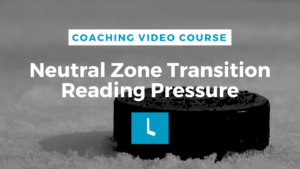(Transcribed from How to Play Hockey: Our Minor Hockey Coaching Course.)
In the defensive zone, as well as all over the ice, it’s really important to control your skating. Defense is a lot about ‘stops and starts’ and skating in straight lines. The alternative to that is,we call it ‘fishing for the puck’ and taking big circles like an ocean liner, rather than stop and start.
[maxbutton id=”2″ ]
Example #1:
We are in possession of the puck in the right corner of our defensive zone.
- Our RW is going to take a straight line directly to the half wall to be an outlet option for our potential breakout.
- If we lose puck possession he/she will take the same straight line back to his/her defensive position, in line with the dots and tops of the circle as a guideline. As spoken in previous videos.
- If the puck gets to the RW point, he/she take a direct line towards the opposing D to be in the shooting lane.
- If that opposing D moves the puck back down, into a prime scoring area our RW takes a direct route to get involved and help out.
Notice that with all of these examples we just touched on above the RW is always taking ‘direct’ routes in ‘straight’ lines. If you skate out to your point coverage lets say and take a loop when the puck moves back down low instead of these straight line routes, you will only cause issues for yourself.
By skating in straight lines and integrating stops and starts you’ll stay in the defensive side of the puck and will have the ability to stay in the shooting lanes. As well get back into position much more efficiently.
Never going a hundred miles an hour deciding, “Are you going in to commit? Or are you going to contain and stall in straight lines?”
Example #2:
The same guidelines we used above with our RW also falls into place for our D.
- Going from the front of the net to cover their high FWD. Straight line, stick in passing/shooting lane.
- Or if the puck switches sides behind the net to the opposite corner, that net front D takes the simple straight line route across the net front to the corner, not looping low around the net.
Never floating, cruising, hoping, always in straight lines. A good honest defense is about controlled skating and stops and starts.
Looking to download half ice hockey practice plans, goalie drills for teams (not a goalie coach?!) or small area games drills? We’ve got you covered too. Click here. Perfect for recreational level coaches.





